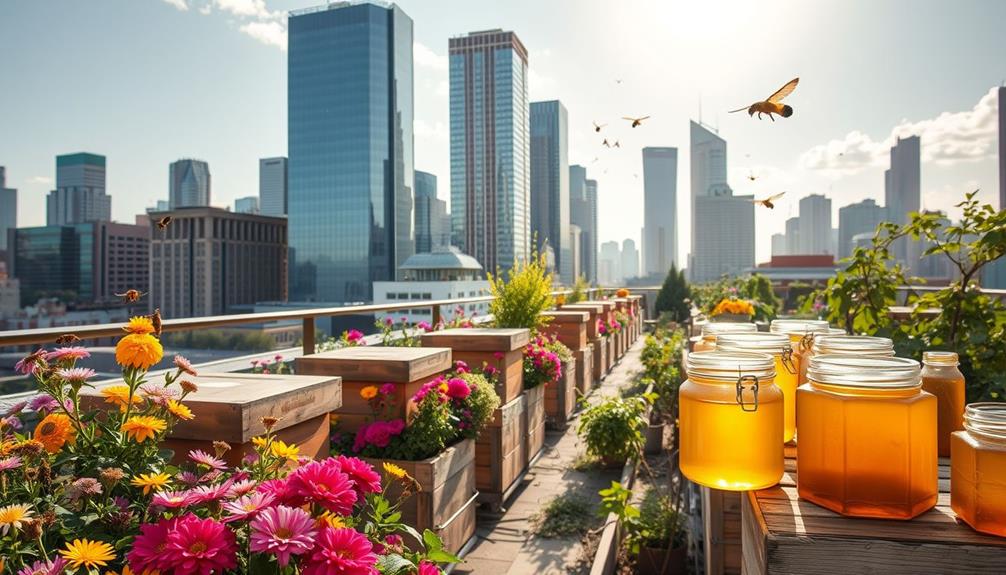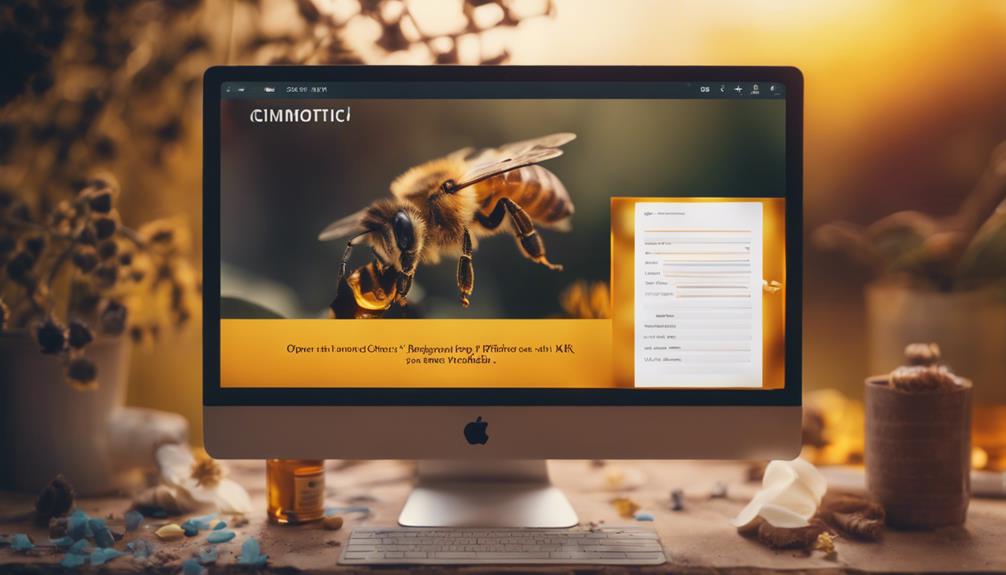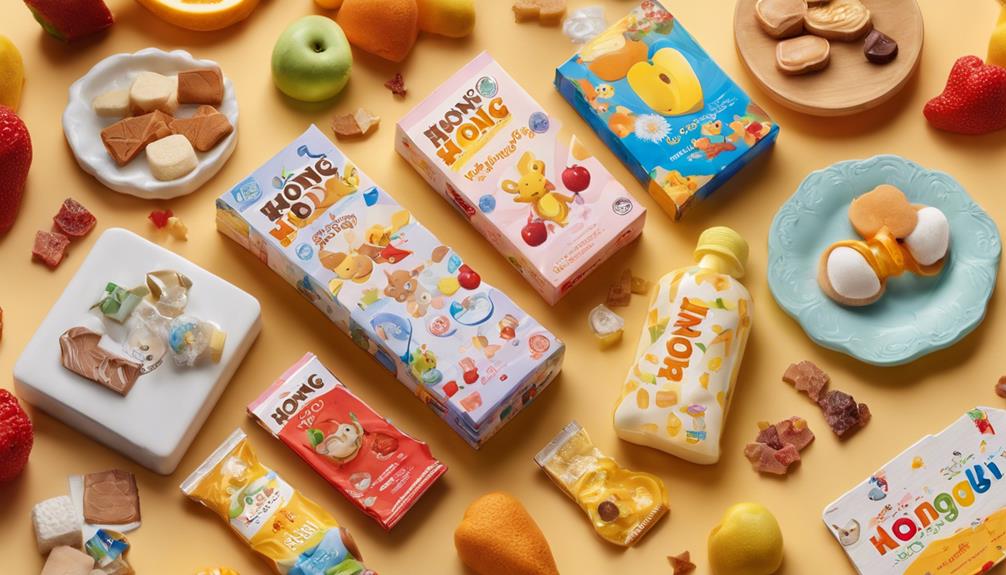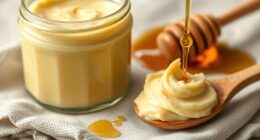To maximize late-season honey as an urban beekeeper, focus on planting diverse flowering plants like goldenrod and asters in your garden. Their late blooms provide vital nectar sources, ensuring your bees have ample foraging opportunities. Strategic hive placement in these areas will optimize honey production. Regular inspections will keep your colonies healthy and thriving, essential during this period. Engaging with community gardens can enhance your bees' nutrition. Remember, the warmer microclimates in cities extend blooming periods, which is a real advantage. Keep exploring ways to bolster your late-season yields and make your urban hive a sweet success!
Key Takeaways
- Plant late-blooming flowers like goldenrods and asters in urban areas to provide continuous nectar sources for bees as they prepare for winter.
- Utilize strategic hive placement near diverse floral resources to optimize honey production and enhance bee foraging opportunities.
- Regularly monitor urban bee colonies for health and competition, ensuring they have access to sufficient nutrition and reducing disease transmission risks.
- Engage with community gardens and local initiatives to create more foraging opportunities and foster a supportive environment for urban beekeeping.
- Implement sustainable honey extraction practices to prioritize bee health while maximizing honey yield from urban hives.
Benefits of Urban Beekeeping
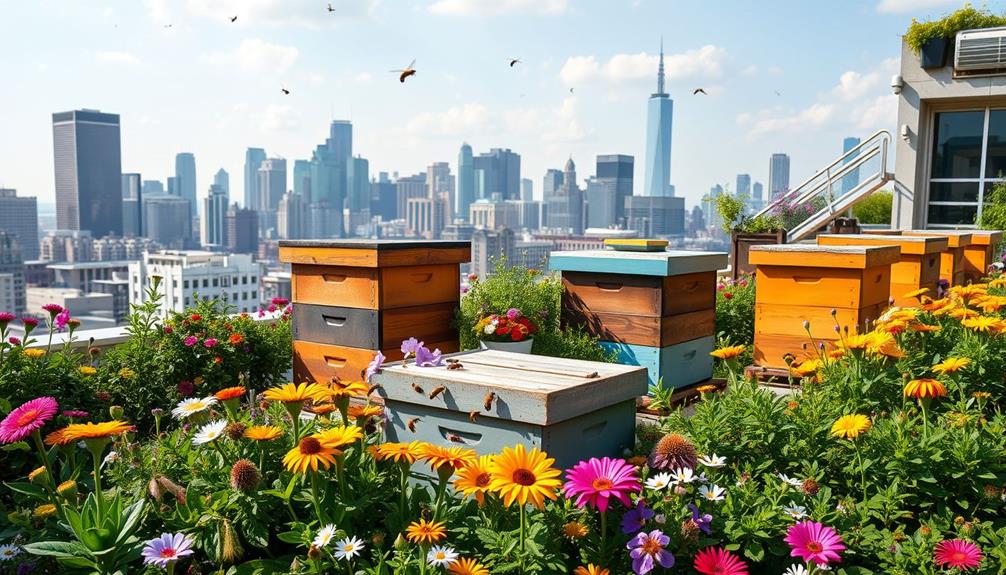
Urban beekeeping offers a unique opportunity to harness the benefits of city life for both bees and humans. In urban environments, you'll find a diverse array of flowering plants that can lead to higher honey yields and healthier bees than their rural counterparts, where monoculture farming dominates. This variety not only enriches the bees' diet but also enhances the flavor of the honey they produce.
Moreover, supporting diverse bee species, such as the Western Honey Bee, can enhance overall pollination and hive health.
Additionally, warmer urban climates often extend blooming periods, providing a continuous nectar supply that supports bee foraging year-round. You'll notice that urban honey tends to have more complex and aromatic flavors, thanks to the wide range of pollen sources available in cities.
Engaging in urban beekeeping also promotes local biodiversity, improving pollination in urban gardens and crops. This is essential for food security in city settings.
Plus, as you participate in this rewarding activity, you foster community awareness about environmental stewardship. Urban beekeeping becomes a platform for educational initiatives that highlight the importance of bee conservation, helping to cultivate a deeper appreciation for these significant pollinators in your community.
Late-Season Floral Resources
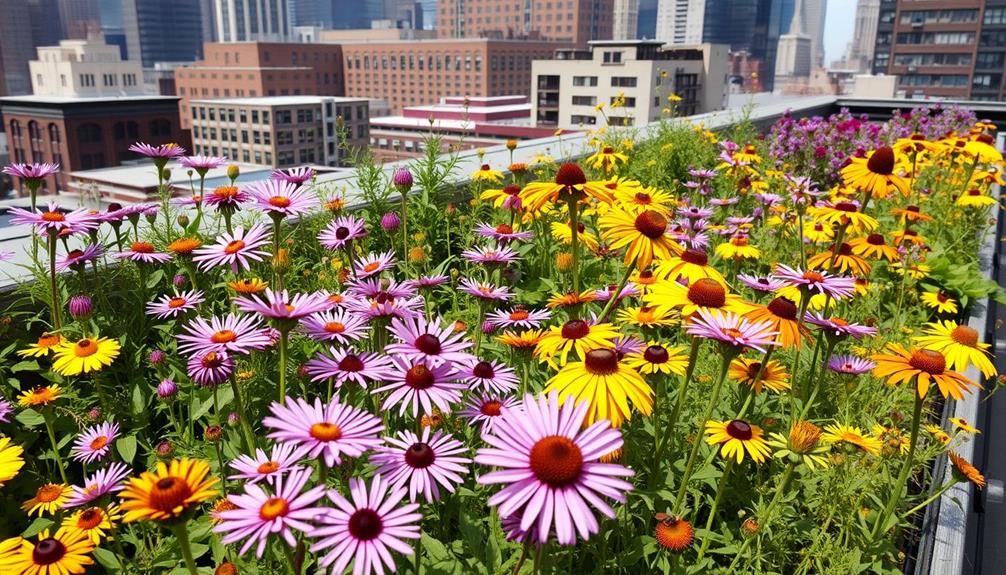
As you explore late-season floral resources in urban areas, you'll notice how seasonal flowering patterns can greatly impact your bees' foraging opportunities.
Plants like asters and goldenrods not only provide essential nectar and pollen but can also boost your honey yield.
Additionally, understanding the diverse unique camping experiences available in various environments can inspire you to create a harmonious space for your bees.
Seasonal Flowering Patterns
Providing late-season floral resources is essential for supporting urban bee populations as they prepare for winter.
Incorporating natural materials like wood and stone in urban gardens can enhance aesthetics while supporting local wildlife.
In urban areas, you can find a variety of late-blooming plants that are critical for bees during this time. These plants not only supply important nectar and pollen but also contribute to the overall health of bee colonies.
Here are three key late-season floral resources you should consider planting in your garden:
- Goldenrod: This vibrant yellow flower blooms from late summer to fall, providing abundant nectar for bees.
- Asters: With their diverse colors and long blooming periods, asters are excellent for attracting pollinators during the cooler months.
- Sedums: These hardy succulents thrive in urban environments and offer a late-season food source that bees love.
Urban Foraging Opportunities
While many might think bees struggle in cities, urban environments actually offer rich foraging opportunities late in the season.
You'll find a diverse range of late-blooming plants like asters, goldenrod, and sedum thriving in community gardens, parks, and even private balconies. These floral resources extend the bees' foraging window well into the fall months.
Urban areas create warmer microclimates that can prolong blooming periods, guaranteeing a continuous nectar supply. This is especially beneficial during late summer and early fall when rural landscapes often lack floral diversity due to monoculture farming.
By enhancing urban landscapes with more late-blooming plants, you can't only support bee health but also help mitigate food scarcity risks for these important pollinators.
As you explore your urban surroundings, pay attention to how these late-season flowers provide essential resources for bees.
Your efforts in cultivating these plants can greatly enhance the local ecosystem, ultimately contributing to a more productive urban beekeeping experience.
Impact on Honey Yield
The abundance of late-season floral resources in urban environments greatly boosts honey yield for beekeepers.
Urban landscapes offer a diverse array of plants, such as asters and sedums, that bloom when rural areas often have limited floral options. This variety contributes to higher honey production, as bees can tap into rich nectar sources throughout the blooming season.
Here are three key factors that enhance honey yield in cities:
- Extended Blooming Periods: Warmer microclimates in urban settings prolong flowering times, allowing bees to forage later into the season compared to their rural counterparts.
- Diverse Nectar Sources: The greater variety of plants in urban areas means that bees collect nectar from a wide range of sources, leading to more robust and aromatic honey.
- Community Gardens and Green Spaces: These local initiatives not only provide additional flowering plants but also support bee health, ensuring a steady food supply during critical foraging months.
Managing Urban Bee Colonies
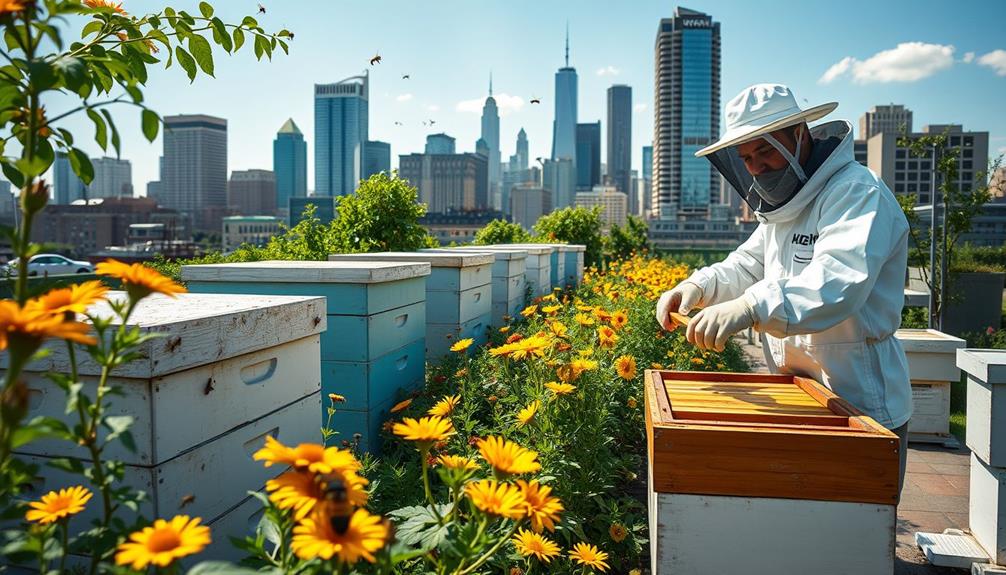
Effectively managing urban bee colonies requires careful planning and awareness of the unique challenges these environments present. Start by strategically placing your hives to optimize access to diverse floral resources. This not only enhances honey production but also supports bee health throughout the growing season.
Remember, urban environments can lead to increased competition for resources and potential exposure to pollutants, so regular monitoring of bee health is essential.
Consider using hive types that fit limited spaces, like top-bar hives. They make management and honey extraction easier in tight environments. Additionally, engaging with your local community can foster a supportive atmosphere for your bees. Educate your neighbors about the benefits of bees to reduce potential conflicts.
Proactive management strategies are vital in urban settings, especially given the higher density of hives, which can facilitate disease transmission. Regularly check for signs of diseases, and don't hesitate to implement measures to keep your colonies healthy.
Techniques for Honey Production
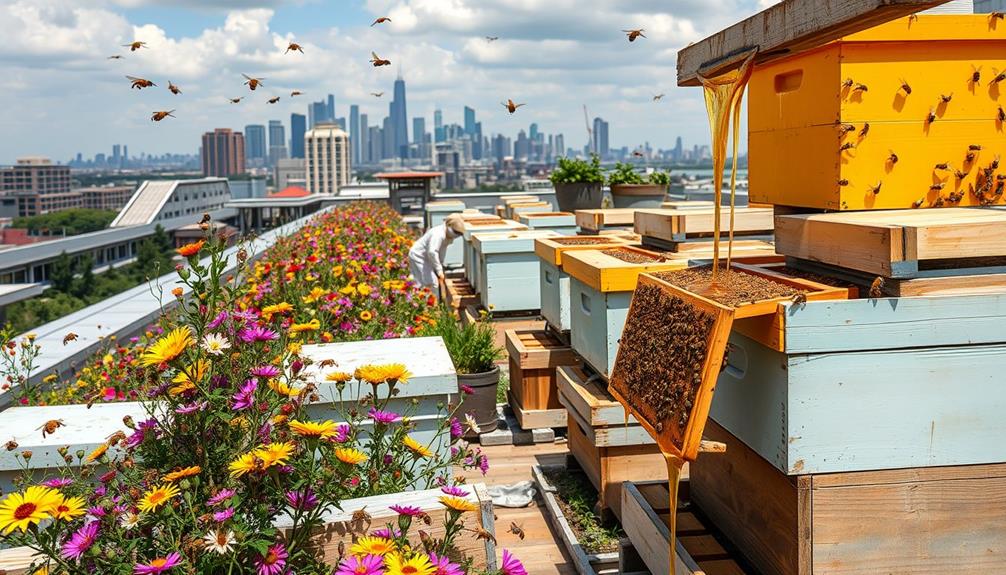
How can you boost honey production in an urban setting? Maximizing your late-season honey yield requires a mix of strategic planning and thoughtful practices. Here are three effective techniques you can implement:
- Plant Late-Blooming Flora: Fill your garden with diverse plants that flower in late summer and fall. This guarantees your bees have a steady nectar source during vital months, boosting honey production.
- Utilize Efficient Hive Types: Consider using top-bar or Langstroth hives. These designs allow for better management of honey supers, making it easier to extract honey without disturbing the bees' natural behaviors.
- Conduct Regular Inspections: Stay vigilant with regular hive inspections. Monitoring for diseases and pests is essential in urban environments, as healthy colonies are far more productive.
Additionally, adopt sustainable practices like minimal honey extraction and letting your bees winter on their honey.
Collaborating with local gardens can also create more foraging opportunities for your bees.
Bee Nutrition in Cities

Urban environments offer a remarkable variety of floral resources that can greatly enhance bee nutrition. You'll find parks, gardens, and even balconies filled with plants, providing a continuous nectar supply vital for your bees' health.
Studies show that urban bees often access a broader range of pollen sources compared to their rural counterparts. This diverse diet considerably boosts their overall well-being.
Moreover, urban settings typically experience less pesticide exposure, allowing your bees to forage more safely and reducing the risk of harmful chemical intake.
The seasonal blooming patterns in cities can also extend beyond those in rural areas, ensuring that your bees have ongoing food sources well into the late season.
Research indicates that urban bees can sometimes thrive better than their rural peers due to this abundance of diverse food sources.
You may notice increased honey production as a result, which is a considerable benefit of urban beekeeping.
Challenges of Urban Beekeeping
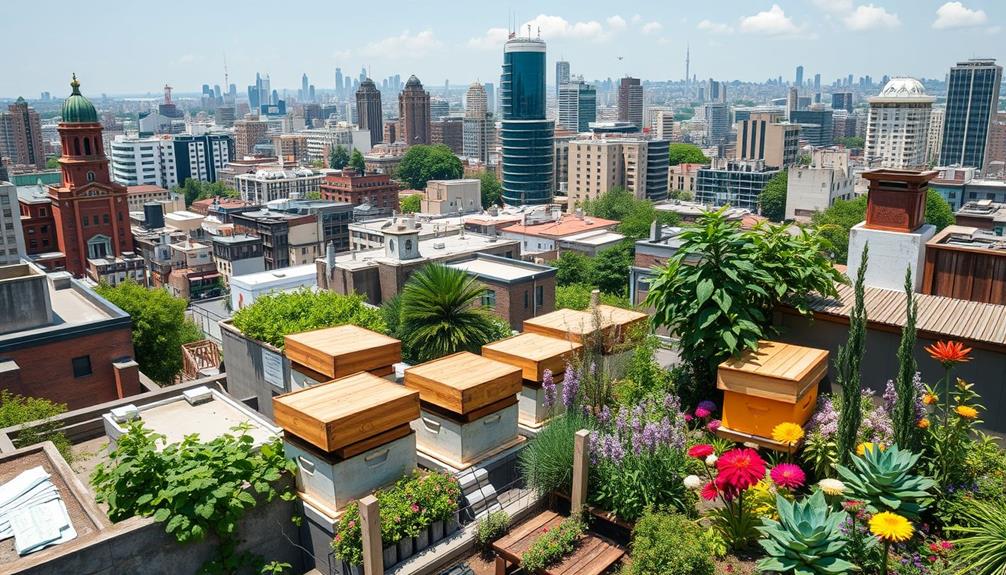
Beekeeping in cities can present unique challenges that require careful navigation.
You'll quickly discover that limited space for hive placement is a significant issue. In densely populated areas, maintaining ideal hive density becomes tricky, impacting your bees' overall health and productivity.
Additionally, the high bee density in urban environments often leads to competition for nectar sources. This competition can threaten the food supply for both your honeybees and native pollinators.
Moreover, disease transmission risks increase due to the proximity of multiple hives. This necessitates proactive monitoring and management to keep your bees healthy.
Lastly, you'll need to navigate potential regulatory restrictions and conflicts with neighbors about where to place your hives. Clear communication and compliance with local laws are essential to avoid disputes.
To summarize, here are three key challenges you may face as an urban beekeeper:
- Limited space for hive placement affecting hive density.
- Competition for nectar leading to food shortages.
- Increased disease risk necessitating diligent monitoring.
Community Engagement and Education
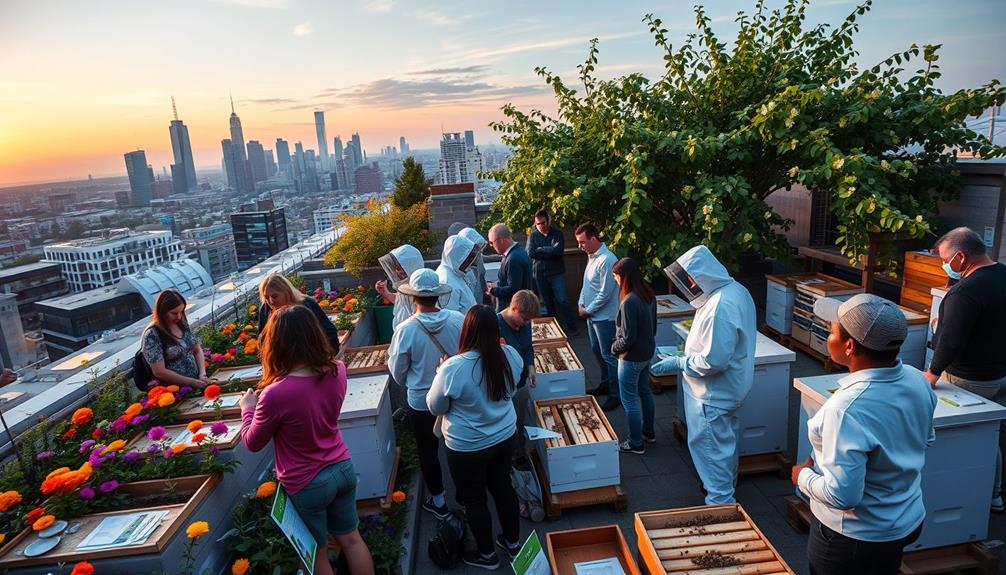
Community engagement in urban beekeeping plays a significant role in fostering a supportive atmosphere for both novice and experienced beekeepers. By participating in workshops and training sessions, you can connect with others who share your interest and learn valuable skills.
These initiatives create a collaborative environment where everyone can thrive.
Local schools are increasingly embracing programs focused on beekeeping, which helps raise awareness about the importance of bees and pollination among younger generations. Engaging students in these educational efforts cultivates a sense of responsibility and appreciation for our pollinators.
Community gardens often serve as vital habitats for bees, and you can help promote their establishment through events that highlight the benefits of local flora. This not only supports bee nutrition but also enriches your community.
Urban beekeeping networks enable knowledge sharing among beekeepers, allowing you to exchange best practices and experiences that enhance honey production and bee health.
Participating in events that promote local honey and bee products educates the community about urban beekeeping's benefits while supporting local economies. By getting involved, you contribute to sustainable practices that benefit everyone.
Legal Considerations for Beekeepers
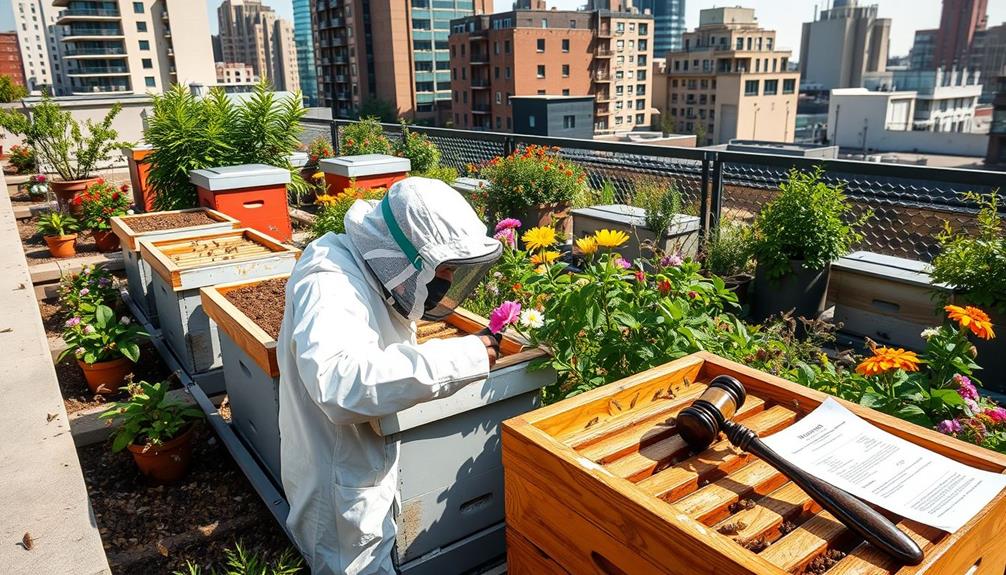
Understanding the legal landscape is essential for any beekeeper looking to establish hives in an urban environment. Before you get started, make sure you're aware of the local regulations that govern beekeeping in your area. Many cities require you to register your beekeeping activities and follow specific zoning laws regarding hive placement.
Here are three key legal considerations to keep in mind:
- Distance Requirements: Generally, beehives should be placed five to twenty meters away from residential properties to minimize conflicts with neighbors.
- Permit Verification: While many cities don't require special permits for hives on personal property, it's vital to check your local laws to avoid any legal issues.
- Neighbor Communication: Before installing your hives, talk to your neighbors. Address any concerns they may have to foster a harmonious relationship within your community.
Being mindful of these legal considerations will help you manage your hives responsibly and maintain positive relations with those around you.
This way, you can focus on what you love—beekeeping—without the worry of potential disputes.
Future Trends in Urban Beekeeping

As urban beekeeping continues to grow, you'll notice a shift towards sustainable hive management practices that prioritize bee health and environmental balance.
Community engagement initiatives will also become key, encouraging local residents to transform their spaces into vibrant, bee-friendly habitats.
Together, these trends will shape a more resilient and thriving urban ecosystem for both bees and people.
Sustainable Hive Management Practices
Sustainable hive management practices are essential for urban beekeeping, especially as cities aim for greener environments.
By focusing on organic methods and minimizing chemical interventions, you can create a healthier habitat for your bees.
Here are three key practices to evaluate:
- Diverse Food Sources: Verify your bees have access to a variety of natural food sources throughout the blooming season. This diversity not only supports their nutrition but also helps maintain strong colonies.
- Space-Efficient Hive Designs: Adopting top-bar hives or other compact hive designs allows you to manage your colonies effectively in limited urban spaces. These designs also encourage bees to exhibit their natural behaviors, fostering a more resilient hive.
- Regular Monitoring: Conduct consistent health assessments of your hives. This proactive approach enables you to identify and address potential issues early, keeping your colonies robust and productive, particularly during late-season honey production.
Community Engagement Initiatives
Urban beekeeping thrives not only on effective hive management but also on the vibrant connections between beekeepers and their communities. You can see this through various community engagement initiatives that are sprouting up in urban areas.
Workshops and training sessions have greatly increased participation rates among novice beekeepers in cities like Berlin and Hamburg. These events empower you to gain hands-on experience and knowledge.
Collaborations with local schools are also becoming common, where educational programs about bees foster a new generation of environmentally conscious individuals. By involving young minds, you're helping to guarantee the future of urban beekeeping.
Additionally, events promoting local honey and related products not only raise awareness but also stimulate local economies. They support small businesses and eco-tourism, making urban beekeeping a community benefit.
Community gardens are emerging as essential habitats for bees, enhancing biodiversity and providing food sources for both honeybees and native pollinators.
Frequently Asked Questions
Why Are Bees Important in the City?
Bees are essential in the city because they pollinate plants, support biodiversity, and contribute to food security. Their presence enhances urban ecosystems, making your environment healthier and more sustainable for everyone, including future generations.
When Is the Last Honey Harvest of the Year?
Imagine harvesting honey in late September, just before the first frost. You'll find that the last honey harvest typically occurs in late summer to early fall, ensuring your bees have enough food for winter survival.
How Much Honey Is Produced in Germany Each Year?
Germany produces around 30,000 to 40,000 tons of honey annually. With about 120,000 beekeepers, urban areas often yield up to 30% more honey due to diverse floral resources compared to rural locations.
Can Honey Be Harvested Too Late?
You can definitely harvest honey too late! If you wait too long, honey's quality drops and bees might struggle through winter. Keep an eye on conditions, and harvest before the first frost to guarantee success.
Conclusion
In urban beekeeping, you can cultivate a thriving hive, harvest late-season honey, and contribute to biodiversity. You'll discover the joy of engaging with your community, educating others about the importance of bees, and advocating for sustainable practices. By overcoming challenges, managing your colonies, and maximizing floral resources, you're not just producing honey; you're fostering a healthier urban ecosystem. So, embrace the buzz, share the sweetness, and let your passion for beekeeping flourish in the city!
